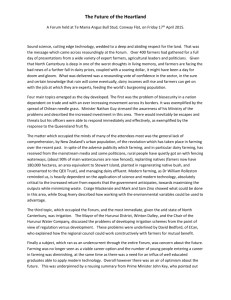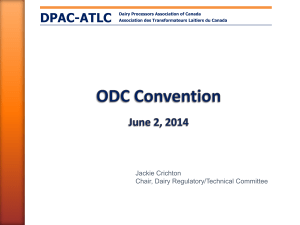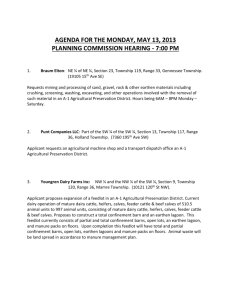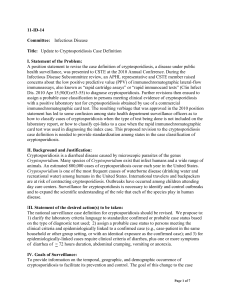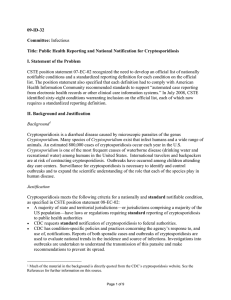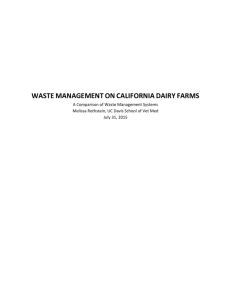Ambia Julie Terry Abstract
advertisement
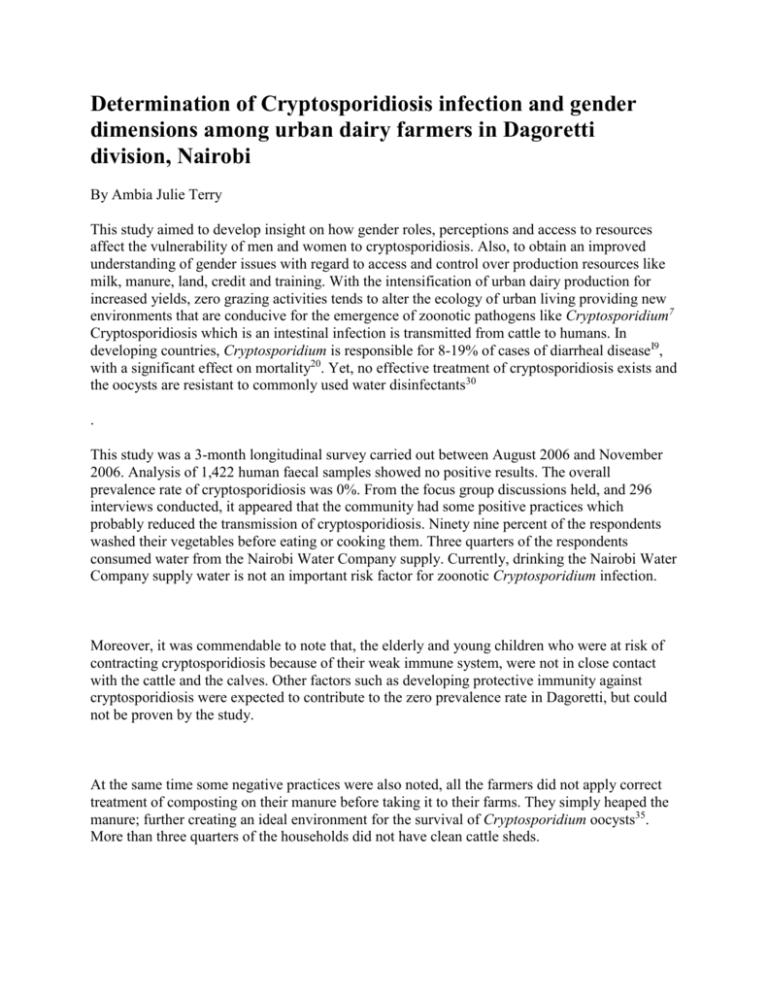
Determination of Cryptosporidiosis infection and gender dimensions among urban dairy farmers in Dagoretti division, Nairobi By Ambia Julie Terry This study aimed to develop insight on how gender roles, perceptions and access to resources affect the vulnerability of men and women to cryptosporidiosis. Also, to obtain an improved understanding of gender issues with regard to access and control over production resources like milk, manure, land, credit and training. With the intensification of urban dairy production for increased yields, zero grazing activities tends to alter the ecology of urban living providing new environments that are conducive for the emergence of zoonotic pathogens like Cryptosporidium7 Cryptosporidiosis which is an intestinal infection is transmitted from cattle to humans. In developing countries, Cryptosporidium is responsible for 8-19% of cases of diarrheal diseaseI9, with a significant effect on mortality20. Yet, no effective treatment of cryptosporidiosis exists and the oocysts are resistant to commonly used water disinfectants30 . This study was a 3-month longitudinal survey carried out between August 2006 and November 2006. Analysis of 1,422 human faecal samples showed no positive results. The overall prevalence rate of cryptosporidiosis was 0%. From the focus group discussions held, and 296 interviews conducted, it appeared that the community had some positive practices which probably reduced the transmission of cryptosporidiosis. Ninety nine percent of the respondents washed their vegetables before eating or cooking them. Three quarters of the respondents consumed water from the Nairobi Water Company supply. Currently, drinking the Nairobi Water Company supply water is not an important risk factor for zoonotic Cryptosporidium infection. Moreover, it was commendable to note that, the elderly and young children who were at risk of contracting cryptosporidiosis because of their weak immune system, were not in close contact with the cattle and the calves. Other factors such as developing protective immunity against cryptosporidiosis were expected to contribute to the zero prevalence rate in Dagoretti, but could not be proven by the study. At the same time some negative practices were also noted, all the farmers did not apply correct treatment of composting on their manure before taking it to their farms. They simply heaped the manure; further creating an ideal environment for the survival of Cryptosporidium oocysts35. More than three quarters of the households did not have clean cattle sheds. With regards to gender roles, it was eminent that, both men and women had equal opportunities in accessing extension agents and training in dairy farming. With access to first hand information both men and women dairy farmers have increased knowledge on how to reduce the health risks posed by cattle to humans. Land ownership among women had augmented due to an increased purchase of land by women and inheritance. Also, women were identified as the people controlling funds derived from the sale of milk. This played a part in increasing their status and bargaining power within the household and community. Both women and men had equal opportunities in accessing credit and loans from financial institutions or informal sources such as the self help groups to improve the dairy farming enterprises. Some of the money obtained from the loans can be used to improve the dairy farming enterprise for greater production efficiency. Also, this will enable them to implement better anti-cryptosporidiosis prevention strategies, such as constructing cattle shed with cemented floors to facilitate easier cleaning. Excluding the hired worker, the quantitative data showed that men and women participated equally in the dairy operations. The findings in this study may be a reflection of improvement of gender aspects in relation to urban dairy farming. It appears that women's workload on dairy farming is becoming lighter in this community. The gaps in implementing ideal practices such as wearing of protective clothing, proper hand washing, composting of manure and ideal shed cleaning practices should be addressed by the extension officers. Continued involvement of training women in dairy farming should be emphasized. Also, there is need for the authorities to provide a coherent legal and policy framework governing urban dairy farming.
